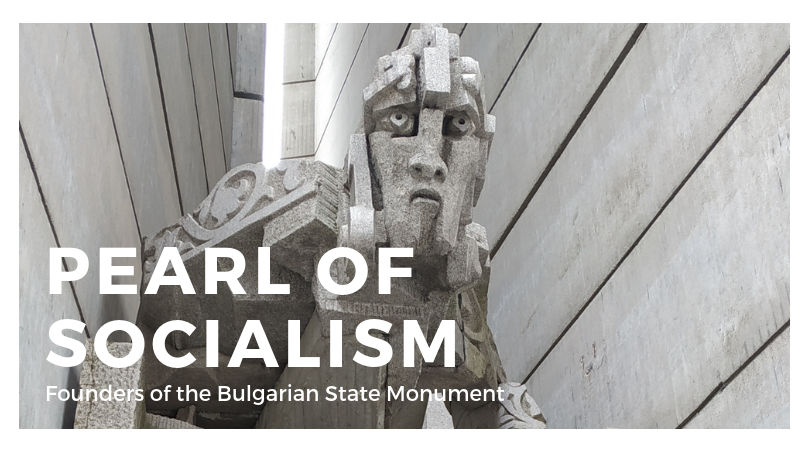Pearl of socialist architecture
Bulgaria is very rich of socialist architecture. You can hardly not notice some memorial or statue basically in every village. But some of those buildings are exceptionally outstanding. Founders of the Bulgarian State Monument amazed me at first glance. And the best thing is that the city of Shumen, where the monument is, offers much more than that.
Shumen is a city older than Bulgaria itself. It was founded about 1200 BC when the area was occupied by Thracians, Romans, Byzantines, and Bulgarians. The remains of those cultures are still there. Take a break for a couple of days and make a trip through history.
Other places to visit in Shumen region
Shumen is also rich in churches, museums, and in the heart of the city, you will find Tombul Mosque, the biggest on the Balkan peninsula. Near the monument is Shumen Fortress. Several kilometers far is Shumen Plateau Nature Park, Madara reserve, and remains of the oldest Bulgarian capitals Pliska and Veliki Preslav.
The Founders of the Bulgarian State Monument
Built in the year 1981 in honor of the 1 300th anniversary from the establishment of the First Bulgarian Empire.
The architectural style: cubism
The Authors: Krum Damyanov and Ivan Slavov
When you enter this place, you feel like in a movie from the future, or in a temple dedicated to the main god of gods, or both at the same time. It’s huge and perfectly preserved, like new. All lines are sharp, all surfaces smooth. It’s all just concrete, but the feeling is pretty much the same as being among pyramids of polished marble. You are small as a worm, but you look in the eyes of the knights with guns, and you feel protected. Of course, this is a very subjective perception. A friend of mine felt the exact opposite and told me that he had nightmares after visiting this place, and many people would see just a mountain of concrete.
So or so, the Founders of the Bulgarian State Monument stands on a hill above the city 450 m above sea level and it’s visible from 30 km distance. You can walk there on a processional stairway from Shumen and eventually enjoy the view over the city and pretend that it’s sooooo beautiful, you can’t tear your glance off, just to have a little more time to take a breath before going back. Or you can go by car to the very top, lose all the fun, post a selfie on Facebook and not waste more than 10 minutes. Everyone can choose according to his preferences or abilities – the second version is available also for wheelchairs.
Find info about entry fee on the official website: http://www.ab-bg.com/bg1300/uslugi.php
The symbolism of the Founders of the Bulgarian State Monument
Here I dare to share a citation of official Bulgarian travel web www.bulgariatravel.org because I couldn’t say it better. If you decided to go there, you will want to have the following text beside yourself to know what you actually see.
The monument consists of two groups of concrete blocks separated from one another by small spaces. The biggest outdoor mosaic-triptych in Europe can be seen here. Together with 21 sculptures, they symbolize the establishment, development, and progress of the Bulgarian state in the period 7th – 10th centuries.
Khan Asparuh (who is considered to be the founder of Bulgaria) is depicted first, standing with his sword stuck in the ground, hands raised and pointing in different directions to where the Bulgarian state will be. His sculpture is followed by the 18 m-tall sculptures of Tervel, Krum, and Omurtag (Bulgarian khans who reigned in the 8th and the 9th centuries). They are surrounded by fragments of old Byzantine chronicles. The wise thought of Khan Omurtag is inscribed beneath them: “Even if a man lives well, he dies and another one comes into existence. Let the one who comes later, upon seeing this inscription, remember the one who had made it… And the name is Omurtag, Kanasubigi.”
A cross of light forms at the upper part of the monument as a symbol of the Christian religion that Bulgarians converted to in the 9th century.
11 figures represent the Golden Age of Bulgaria under the reign of Simeon the Great (893 – 927). The sculpture of the ruler is surrounded by men of letters, boyars, and soldiers. A reproduction of a section of the fortress wall of Veliki Preslav (Great Preslav – an old Bulgarian capital) lies opposite this composition.
The concrete panels on which the mosaic-triptych is laid are arranged at different angles so as to demonstrate the gradual development of the state.
A granite lion weighing 1000 tons is placed on the top of the memorial.
The development of the Bulgarian state is demonstrated by three different types of the alphabet: the first one is runic, composed of cuts and lines used by Proto-Bulgarians and Slavs, followed by the Glagolitic alphabet created by the brothers Cyril and Methodius and ending with the Cyrillic alphabet – the writing system of all Slavonic peoples.







